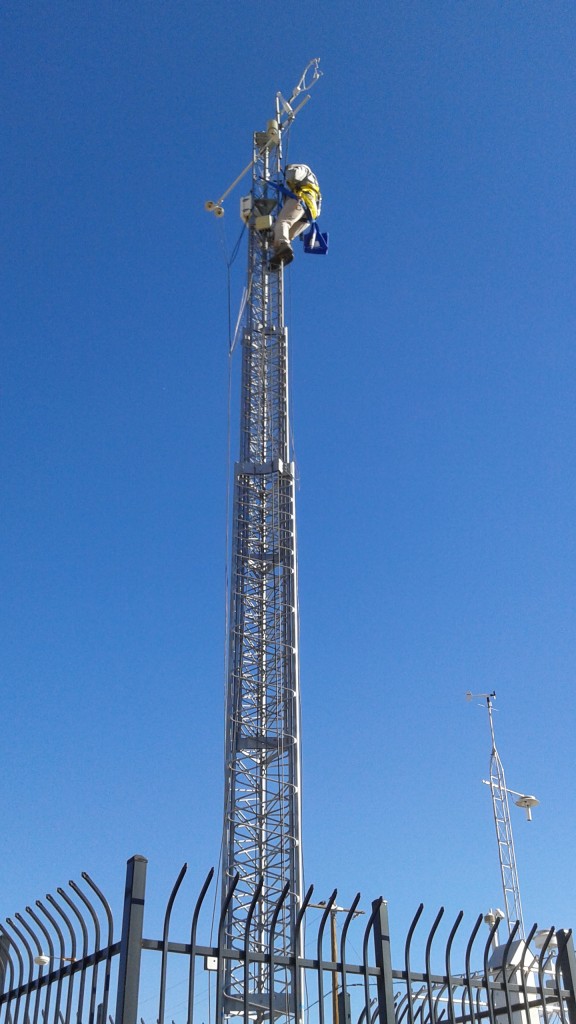Urban Flux Tower
 The CAP LTER maintains a flux tower to facilitate neighborhood-scale investigations of atmospheric processes in a Phoenix, AZ suburb. Capitalizing on comprehensive measurements of energy (heat and radiation) and matter (water and carbon dioxide) exchanges between the atmosphere and the urban surface, this project adds significantly to research investigating how urbanization affects local weather, climate, and air quality. Results of this study are contributing greatly to our understanding of climate issues pertinent to urban areas, such as the urban heat island (UHI), climate forecasting, air quality, and yardscape water demands and consumption. Further, this research provides critical on-the-ground data required to validate regional climate models that influence water management and emergency planning. Ultimately, these data may contribute to urban design and management that aid the conservation of resources and ameliorate temperature extremes.
The CAP LTER maintains a flux tower to facilitate neighborhood-scale investigations of atmospheric processes in a Phoenix, AZ suburb. Capitalizing on comprehensive measurements of energy (heat and radiation) and matter (water and carbon dioxide) exchanges between the atmosphere and the urban surface, this project adds significantly to research investigating how urbanization affects local weather, climate, and air quality. Results of this study are contributing greatly to our understanding of climate issues pertinent to urban areas, such as the urban heat island (UHI), climate forecasting, air quality, and yardscape water demands and consumption. Further, this research provides critical on-the-ground data required to validate regional climate models that influence water management and emergency planning. Ultimately, these data may contribute to urban design and management that aid the conservation of resources and ameliorate temperature extremes.
An antenna-mounted array of sophisticated sensors measuring temperature, humidity, and wind speed and direction at high temporal resolutions facilitates the calculation of energy and material fluxes. This antenna-based approach has been used for similar climate observation campaigns worldwide, including those in Vancouver, Singapore, Basel, Mexico City, Tucson, and London, but this is the first long-term urban flux study in a large, arid city that we are aware. The residential setting where the tower is positioned was selected on account of the homogeneous building design (single-story, single-family, detached dwellings) representative of many neighborhoods throughout the Valley, and also due to generous technical and logistical assistance offered by the Maricopa County Air Quality Department, which maintains a separate air-quality monitoring station at the secure parcel. To avoid the influence of localized turbulence and material fluxes created by anomalous surface objects, the antenna extends vertically approximately 75 ft to sample neighborhood-scale fluxes. Though quite tall, the slender tower profile is minimally disruptive to the skyline.
Owing to extremely large volumes, 10 Hz eddy covariance data from this project are available only upon request to the CAP LTER information manager (caplter.data@asu.edu); however, see the links below for availability of 30-minute averages of those data and other data sets that feature processed data.
Datasets
- Long-term monitoring of micrometeorological conditions at the CAP LTER flux tower located in the west Phoenix, AZ neighborhood of Maryvale, ongoing since 2010
- Eddy covariance data measured at the CAP LTER flux tower located in the west Phoenix, AZ neighborhood of Maryvale from 2011-12-16 through 2012-12-31
- Evaluating water and energy fluxes across three distinct land cover types in a desert urban environment
Publications
Chow, W. T., F. Salamanca, M. Georgescu, A. Mahalov, J. M. Milne and B. L. Ruddell. 2014. A multi-method and multi-scale approach for estimating city-wide anthropogenic heat fluxes. Atmospheric Environment 99(December):64-76. DOI: 10.1016/j.atmosenv.2014.09.053. (link )
Chow, W. T., T. J. Volo, E. R. Vivoni, G. D. Jenerette and B. L. Ruddell. 2014. Seasonal dynamics of a suburban energy balance in Phoenix, Arizona. International Journal of Climatology 34(15):3863-3880. DOI: 10.1002/joc.3947. (link )

